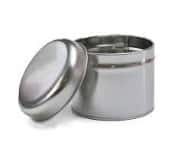Before entering fully into the meaning of the term tin, we are going to proceed to know its etymological origin. In this case, we can indicate that it derives from Latin, exactly from "stagnum", which on other occasions appears written as "stannum". Likewise, it must be stated that "stagnum" was formerly used with two meanings: as a synonym for a pond or as an alloy of silver and lead.
This second meaning, which is the one that has been maintained today, must be established that it began to be used as such in the 1st century and appears for the first time in a writing by Pliny.
Tin is the chemical element whose atomic number is 50 and its symbol, Sn . It is a silver metal whose oxidation occurs easily.
 Tin has a good ability to resist corrosion : that is why it is often used to wrap other elements and thus provide them with protection . Due to its resistance, it is also used in welding and in the manufacture of containers .
Tin has a good ability to resist corrosion : that is why it is often used to wrap other elements and thus provide them with protection . Due to its resistance, it is also used in welding and in the manufacture of containers .
Man began to use tin about three thousand years before Christ . The material soon proved to be useful for making tools and weapons with greater features and better performance than those produced with bones or stones. Furthermore, the alloy of tin and copper made it possible to find an element that changed history: bronze .
In fact, the prehistoric period in which metallurgy based on this alloy of tin with copper was forged is known as the Bronze Age . The tin trade, in this framework, was a very important activity that encouraged travel and gave great importance to the metal deposits.
Other significant characteristics of tin are the following:
-It has a high boiling point and melts at a low temperature.
-The tin mineral that is considered most significant is called cassiterite.
-If we take into account its allotropic form, there are two varieties of this element in question: gray tin and white tin.
-Some varieties of tin can cause damage to the environment, especially affecting fish and also plant species such as fungi.
-Triellitic tin is one of the most dangerous substances that exist for man. A good example of this is that it can cause serious damage to your health such as headaches, problems urinating, irritations of some severity to the skin and also to the eyes, liver failure, sleep disorders, vomiting and dizziness, an excess sweating, brain damage of different types...
Bronze is not the only alloy that can be achieved by combining tin with other metals . Pewter , for example, is composed of lead, antimony, copper, and tin. Pewter is generally used to produce pieces of tableware and ornaments.
It should be noted that, when subjected to a low temperature, tin experiences a phenomenon known as tin plague : it increases in volume , turns grayish and crumbles until it turns into powder.
